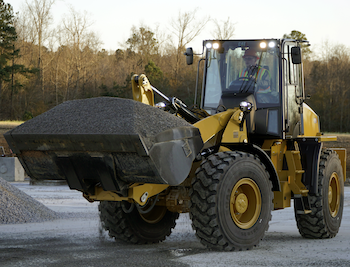New compact wheel loader
The Cat 920 delivers added performance, new features and new options.
The new Cat 920 wheel loader replaces the Cat 918M wheel loader with new options are available, and certain features that were options on former models are now standard. The Cat 920 is also available in an aggregate-handling configuration.
 |
| Cat 920 delivers added performance, new features and new options. |
The Cat C3.6engine replaces the C4.4, bringing a horsepower boost from 117 to 122 horsepower. Caterpillar estimates up to 5 percent gains in fuel-efficiency with the new engine, and the C3.6 meets EU Stage V and U.S. EPA Tier 4 Final emission standards. Fuel-tank capacity also is increased by 2.9 gallons allowing extended work cycles. The reversing fan has a three-position rocker switch in the cab, allowing the system to be turned off, to operate in an automatic mode, or to be momentarily activated by the operator.
A rotary-sensor-kickout system with both fork and bucket settings is now standard. Additional rear guarding is now available and new auxiliary hydraulic lines are available when the three- or four-valve option is selected. Other new options include a reversing fan, LED working and under-hood lights, and USB ports in the cab. In the automatic mode, the fan is factory-set to reverse direction for 10 seconds every 10 minutes. Frequency and duration of automatic reversing can be changed via the Cat Electronic Technician, allowing frequency to be adjusted from 5- to 240-minute intervals and duration from 5 to 20 seconds.
Optional high-illumination LED lights are available for working/roading lights and under-hood-service lights. LED lighting has a truer, cleaner color that helps better illuminate the work area when operating in low-light conditions. In addition, performing under-hood service in poor ambient light is made easier with task-focused LED lighting. Unlike conventional LED roading lights, Cat LED roading lights have a unique resistor bank built into the body to keep the lamp assembly warm enough to melt snow and ice, resulting in added efficiency when operating in such conditions.










